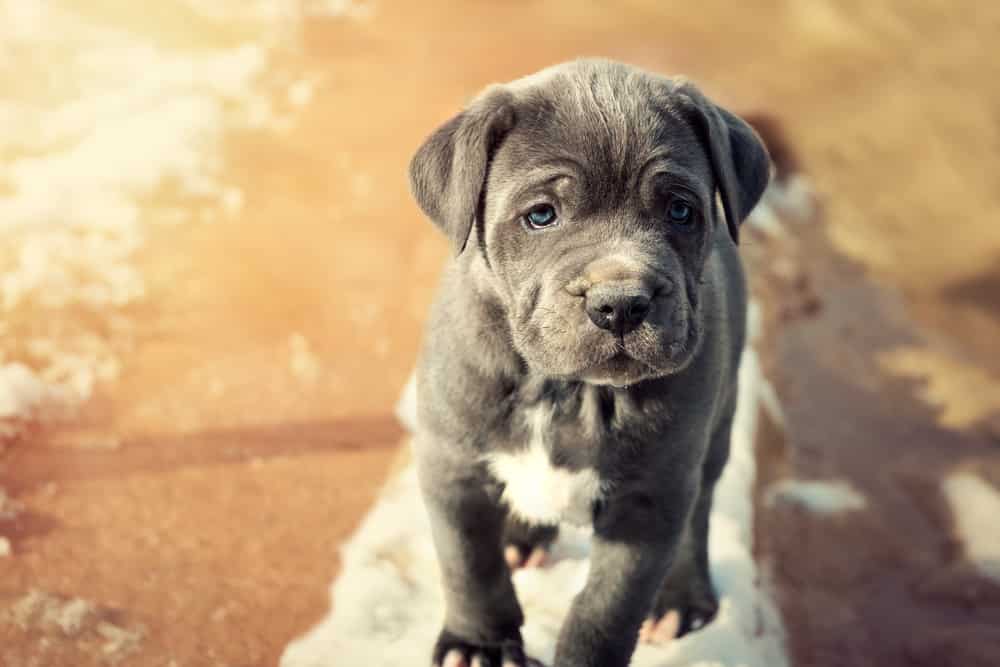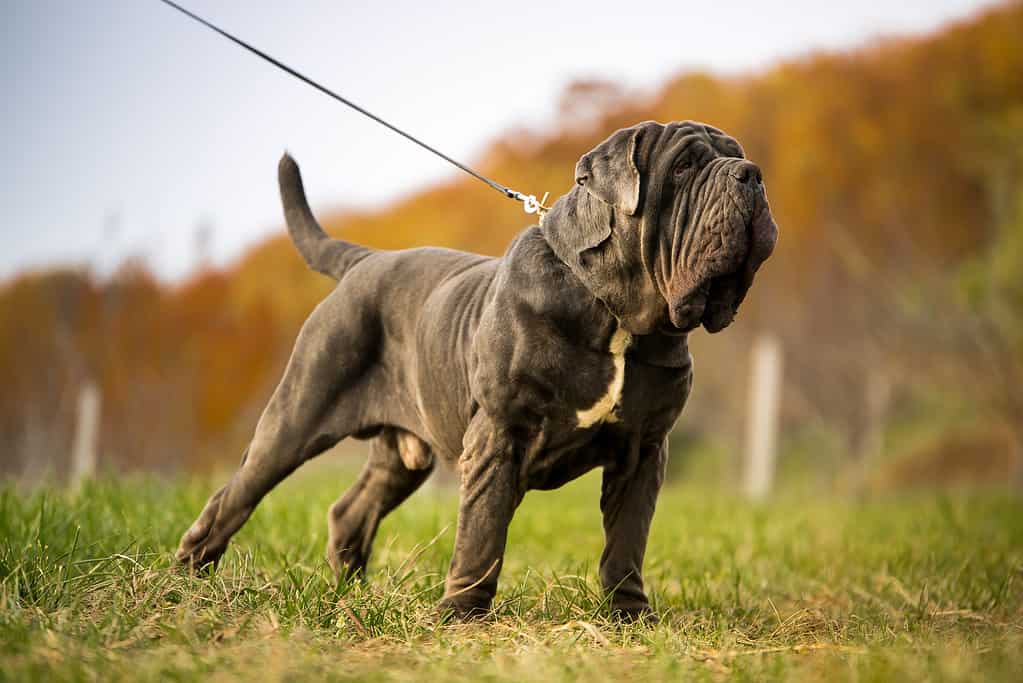Neapolitan mastiffs are the gentle giants of the guard dog breeds. Obviously, they are protective but they are also loving and easygoing making them a wonderful companion. If you are thinking of getting a Neapolitan mastiff pup yourself, you need to be aware that you are taking on one of the giant dog breeds. These dogs need special care with their diet and you need to be especially careful when they are growing puppies. Here we chart the expected growth of a Neapolitan mastiff and list common milestones and tips for new owners.
Breed Summary
The magnificent Neapolitan mastiff is a dignified and watchful breed of guard dog that has its origins in Italy. Their history dates back to 700 BC and they were used by gladiators in the Roman Empire. They are a powerful dog with a striking appearance – thanks to a lot of wrinkles around their face. Their coat is short and can be blue, black, mahogany, or tawny. Some dogs have brindle markings.
Neapolitan Mastiff Growth and Weight Chart by Age
It is always useful to have a rough guide to how your pup should be growing and developing. However, all pups are different. Birth weight can be determined by litter size, maternal health, genetics, and nutrition. Once born, pups develop at different rates. On the whole, male Neapolitan mastiffs are bigger than females but you should always speak to your vet about your pup’s growth and weight gain. Here is an approximate growth and weight chart for Neapolitan mastiffs.
| Age | Male Weight | Female Weight |
| Birth | 1-1.25 lbs | 10-13 ounces |
| 1 Month | 14-16 lbs | 12-14 lbs |
| 6 Weeks | 19-21 lbs | 18-19 lbs |
| 2 Months | 32-42 lbs | 28-31 lbs |
| 3 Months | 45-50 lbs | 38-42 lbs |
| 4 Months | 55-62 lbs | 48-55 lbs |
| 5 Months | 68-78 lbs | 59-68 lbs |
| 6 Months | 78-89 lbs | 70-78 lbs |
| 7 Months | 87-101 lbs | 75- 87 lbs |
| 8 Months | 95-108 lbs | 82-95 lbs |
| 9 Months | 100-118 lbs | 88-105 lbs |
| 10 Months | 110-122 lbs | 90-108 lbs |
| 11 Months | 112-129 lbs | 98-110lbs |
| 12 Months | 115-132 lbs | 108-115lbs |
| 2 Years | 130- 150 lbs | 115-130lbs |
When Will My Neapolitan Mastiff Stop Growing?
Neapolitan mastiffs reach their full size at about 18 months of age along with other larger breeds. Prior to this, it is important to get the balance of exercise and nutrition correct. Your breeder should provide you with some of the food that the pup has been eating. A high-quality commercial food for large breed puppies is suitable and you should follow the feeding guide on the packet. According to the United States Neapolitan Mastiff Club, pups need three meals a day. Schedule regular check-ups with your vet so that you can monitor your pup’s weight and get the best advice.
How Big Will My Neapolitan Mastiff Be When It’s Fully Grown?
These dogs are stocky and heavy-boned. The Breed Standard specifies that males should be between 26 and 31 inches in height whilst females should be 24 and 29 inches high. Males are around 150 pounds and females are around 110 pounds. That said, this is a breed where size matters! It is considered preferable for their weight to be greater than this as long as their bodies are correctly proportioned.
When Should My Neapolitan Mastiff Be Spayed or Neutered?
There is considerable debate surrounding the correct age to get a Neapolitan mastiff spayed or neutered. Whilst many vets and animal shelters advocate spaying before 12 months, some breed enthusiasts claim that the dogs should be 18-24 months old. It is a balance between avoiding unwanted pups and reducing some health risks on the one hand with other health risks introduced by early spaying/neutering on the other. Some studies have suggested that early spaying/neutering of large breeds can increase the risk of joint disorders and some cancers.
When Should My Neapolitan Mastiff Be House Broken?
These pups are usually house broken by six months, some get the hang of it by four months! You can start the process from as young as eight weeks. The US Neapolitan Mastiff Club strongly recommends that you use crate training but the pup must not be left in there for long periods.
When Should My Neapolitan Mastiff Stop Eating Puppy Food?
Your Neapolitan mastiff pup needs a high-quality food designed for large breed puppies. Follow the feeding guidance provided by your breeder and try to use the same food whilst your pup settles in. Then, you can gradually transition to another food over a week or so if you want to. They also need constant access to fresh water but these dogs have a habit of sliming up their water so it will need to be changed regularly.
When Will My Neapolitan Mastiff Start Losing Teeth?
These pups start to lose their teeth at around three months of age. By the time they are six months old, they should have all of their adult teeth. It is important that you brush your dog’s teeth regularly to remove plaque.
When Should I Start Training My Neapolitan Mastiff?
Training a Neapolitan mastiff begins the moment you bring them home. It is important that you show who is in charge right from the start with gentle but firm consistency. These dogs need socialization from an early age. They are watchful dogs who are wary of strangers so this is vital to prevent future problems.
What Cues Should I Teach My Neapolitan Mastiff First?
It is a good idea to get specialist advice from a trainer with experience with this breed. Many owners start with simple commands such as ‘sit’. With such a large breed, it is also vital that they learn to walk politely by your side so ‘heel’ is important.
When Will My Neapolitan Mastiff Calm Down?
According to the American Kennel Club, Neapolitan mastiff pups are active and curious. Then, as they reach adolescence, many are highly energetic. By this time, they are already large dogs and this stage can be challenging. By the time they have reached three or four years, most have become pretty laid back!
Common Health Issues Your Neapolitan Mastiff Might Experience
The breed has a relatively short life expectancy – it could be just seven years. This is because their huge size predisposes them to several health conditions. Some of the most common are:
- Heart disease – including dilated cardiomyopathy which can cause sudden death.
- Allergies – their skin folds are prone to irritation and allergic reactions.
- Gastric dilation and volvulus (GDV) – a severe form of bloat that is potentially fatal.
- Hip and elbow dysplasia – where the joints do not fit together correctly.
Pictures of Neapolitan Mastiff as Puppies

Neapolitan mastiffs are active pups.
©ABO PHOTOGRAPHY/Shutterstock.com
Pictures of Neapolitan Mastiff at 6 Months

As juveniles, Neapolitan mastiffs can be challenging.
©Fomin Serhii/Shutterstock.com
Pictures of Fully Grown Neapolitan Mastiff

Neapolitan mastiffs are a giant breed.
©Okikukai/iStock via Getty Images
The photo featured at the top of this post is © Christian Mueller/Shutterstock.com
Ready to discover the top 10 cutest dog breeds in the entire world?
How about the fastest dogs, the largest dogs and those that are -- quite frankly -- just the kindest dogs on the planet? Each day, AZ Animals sends out lists just like this to our thousands of email subscribers. And the best part? It's FREE. Join today by entering your email below.
Thank you for reading! Have some feedback for us? Contact the AZ Animals editorial team.






